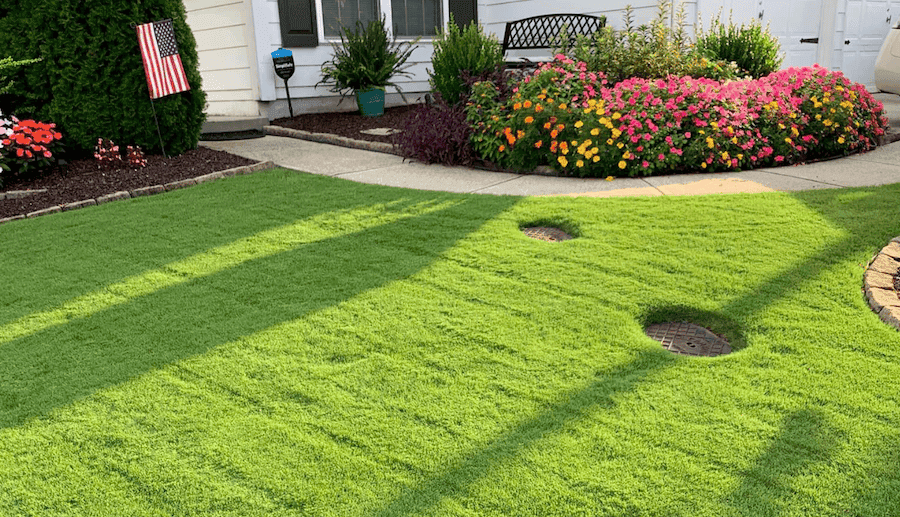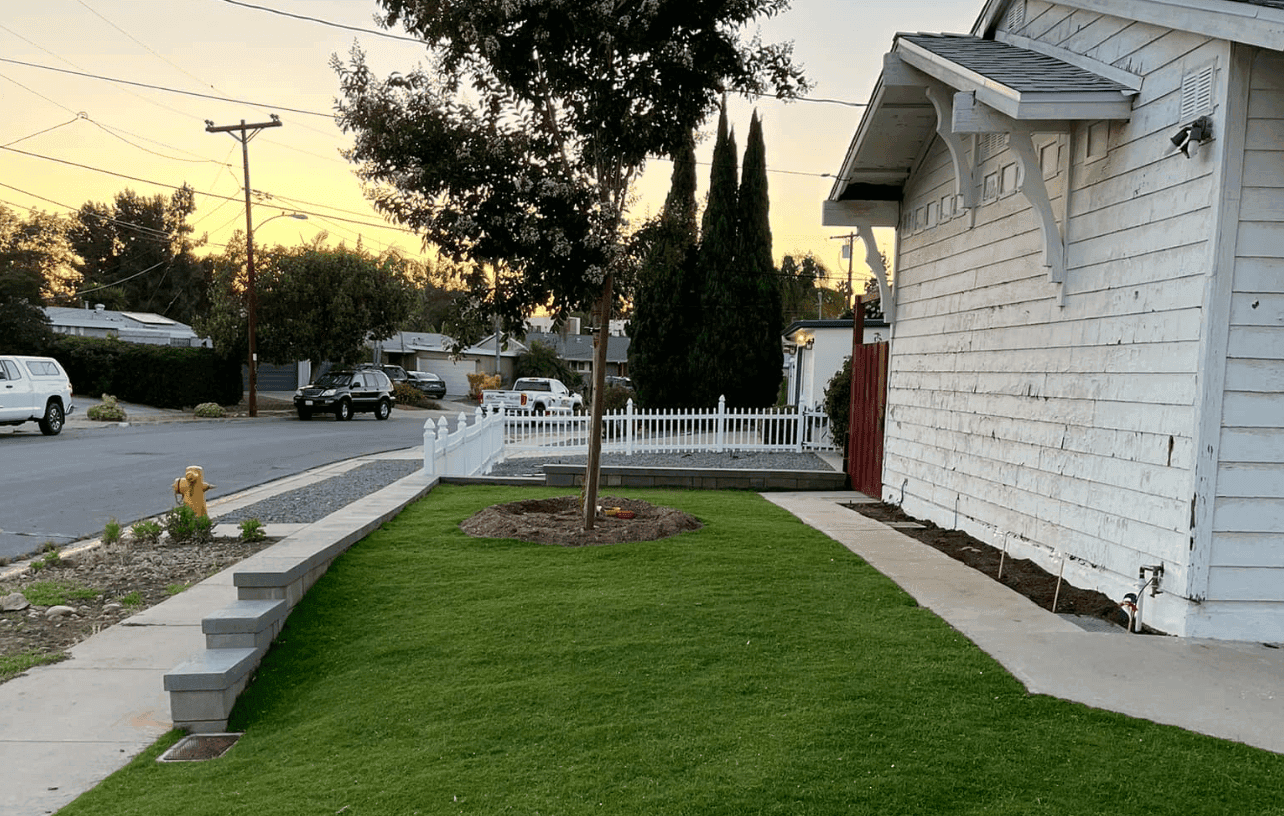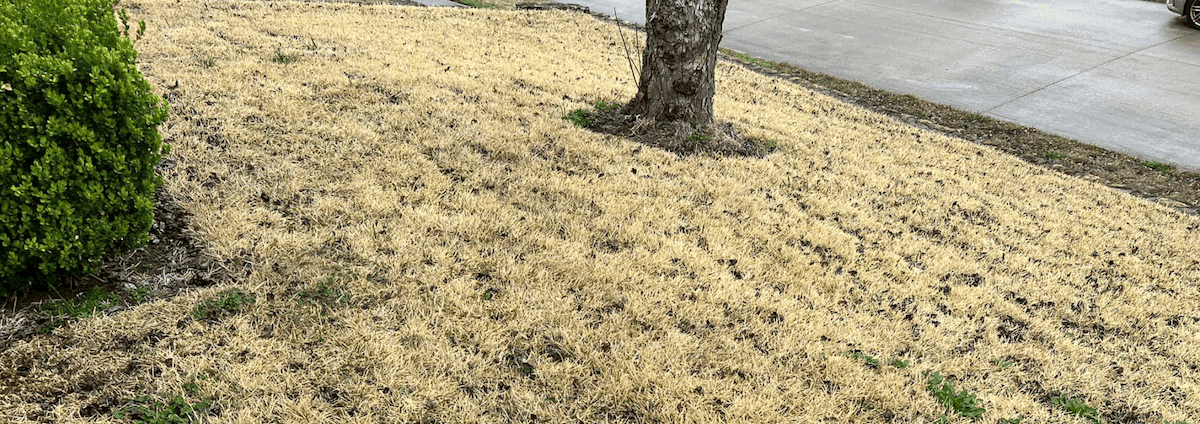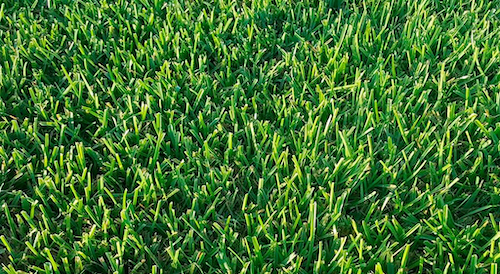In this guide to Bermuda, we'll discuss everything from cost to best mowing height while also looking at the pros and cons. By the end, you'll be perfectly positioned to know whether it's the right sod type for you.
What Is Bermuda Grass Sod?
Bermuda grass sod is a popular choice for lawns. It's known for its durability. We love how quickly it can establish a lush lawn. This is because it spreads fast!
The sod comes from a warm-season grass. It thrives in sunny spots. We see it in the South a lot. But, it can grow in other places with enough sunlight.
Here's why we recommend Bermuda sod:
It's tough: It stands up to foot traffic.
It grows fast: We see quick cover and repair.
Heat-loving: It's perfect for hot, dry areas.
But remember, it needs care. Use the following for the best results:
Water: It's drought-resistant but likes regular watering.
Mowing: Keep it short for that tight, carpet-like look.
Fertilizer: Feed it seasonally to keep it green and happy.
Bermuda grass sod boasts a fine texture. It's a brilliant green that can make any yard pop. It also creates a dense mat. This chokes out weeds. How great is that?
Defining Features
Bermuda sod, also known as Bermudagrass, has specific characteristics that set it apart. Let's go over its defining features.
Texture: Bermuda sod has a fine to medium texture. This makes our lawns look smooth and feel soft.
Color: It sports a beautiful green color. In cold seasons, it may turn brown but greens up fast when temperatures rise.
Growth Patterns: We love Bermuda sod's aggressive growth. It spreads quickly using above-ground stems, called stolons, and below-ground stems, called rhizomes. These make it ideal for recovery from damage.
Maintenance: Bermuda requires regular maintenance. We're talking mowing, watering, and fertilizing. But the good news? It pays off with a stunning lawn.
Mowing height: Keep it between 1.5 and 2 inches.
Watering schedule: It thrives with 1 to 1.25 inches of water weekly.
Fertilization: Feed it during active growth seasons for the best results.
Lastly, Bermuda sod loves the sun. It needs at least 6 hours of full sun a day. So, we make sure to plant it where there's plenty of sunlight. It's tough and can handle a lot of foot traffic, making it a top pick for sports fields and lawns.

When to Lay Bermuda Sod
We need to nail the timing and conditions to get Bermuda sod right. Here's how we do it.
Soil Conditions
Preparation is key. The soil needs to be just right. We want it loose, not compacted. This means tilling to a depth of about 4 to 6 inches. We also gotta check the soil's pH. Bermuda grass loves a pH between 5.8 and 7.0. If it's off, we'll need to adjust with lime or sulfur. Make sure to:
Till the soil
Check pH levels
Amend with lime or sulfur (if needed)
Light Conditions
Bermuda grass likes it sunny. We're talking full, direct sunlight. At least 6 hours a day, but hey, more is better. If we've got shady areas, Bermuda might not be the best pick. Stick to sunny spots for happy grass. Here’s what we keep in mind:
Full sunlight areas
Minimum of 6 hours of direct sun
Avoid shady spots for best growth
Timing is everything, so we lay the sod when conditions are spot-on. This usually means late spring through early summer, when soil temperatures are consistently above 65°F. Temps too low? The roots might not take. Let's make sure we do it right.

Now that we're ready, we lay our sod pieces tightly together. No gaps! We don't want weeds poking through.
After laying down the sod, we water it. Keep it moist for the first few weeks. Not too much! We don't want puddles. After the roots establish, we can cut back on watering.
Mowing comes next. But wait until our grass roots are secure. About 2 inches is a good height for Bermuda. Regular mowing keeps it looking tidy.
And there we have it. A beautiful Bermuda lawn for us to enjoy. It's ideal for backyard BBQs, playing catch, or just chilling in the hammock. Cheers to our new, vibrant green space!
Where to Buy Bermuda Sod
When we're ready to buy Bermuda sod, we've got several go-to places. Let's start with local nurseries. These spots often offer high-quality sod. Plus, they give us the chance to look at the product in person. Support local, right?
Level Up Your Lawn Skills
Once per week we'll send you an interview from someone who has mastered the art of lawn care.
Next, we’ve got landscaping supply companies. They're great because they usually have bulk deals. That's a win if we’re covering a big area.
Don't forget about home improvement stores. Think Home Depot or Lowe's. They often stock Bermuda sod during the planting season. Super convenient for a quick pick-up.
We can also go online. Check out places like Sod Solutions or The Sod Farm. They deliver straight to our doorstep. Can it get any easier?
Here's a breakdown table for a quick glance:
Purchase Option | Pros | Cons |
Local Nurseries | Check quality in person | May be pricier |
Landscaping Supply Stores | Bulk purchasing options | Limited variety |
Home Improvement Stores | Convenience, easy pick-up | Seasonal availability |
Online Stores | Home delivery, wide selection | Can't inspect before buying |
Always remember to check the sod's quality, no matter where we buy it. We want a lush, green lawn, right? So let's make sure the roots are strong and the grass is healthy.
When online, read reviews and ask for samples if possible. It's all about getting the best bang for our buck.
A Note on Measurement: Rolls, Pallets and Square Feet
When we talk about buying Bermuda sod, we measure in rolls, pallets, and square feet. Let's break it down so you know what you're getting.
Rolls: A roll is just what it sounds like – a big roll of grass. Each roll usually covers about 10 square feet.
Pallets: Now, a pallet is a bunch of rolls. Think of it like a big, square platform holding all your sod. One pallet can cover about 500 square feet. That's a lot of grass!
Square Feet: This one's easy. It's just the area of sod you want to cover. Measure your yard's length and width, then multiply. Bam! That's your square footage.
We use these measures to get you the right amount of Bermuda sod for your space. Just make sure you've got your yard measurements handy. Here's a quick table to help you out:
Measurement Unit | Coverage |
Roll | 10 sq ft |
Pallet | 500 sq ft |
Remember, a lush lawn starts with the right amount. Get your numbers straight, and you're halfway to a green paradise!
Choosing an Installation Company
When we're ready to get Bermuda sod installed, picking the right company is key. We want a team that's reliable and transparent about costs.
Our sod calculator can generate a list of reputable sod installers near you that are a good fit for your project.
A Note on Estimates: Prices, Quotes, and the Actual Cost
Let's talk numbers. Estimates might be free, or some companies might charge a small fee that they'll deduct from our final bill if we hire them. We should aim to get a few different quotes to compare. But here's the thing: estimates ain't the final cost.
Why? Well, extra work like land prep or addressing problem areas might add on to the price. And hey, nobody likes surprises when it comes to money. So, we should ask for an itemized sod quote. This breaks down the cost for materials, labor, and any additional services.
We'd be smart to check if the estimate includes the full scope of work. Some details to look out for are:
Soil prep and leveling
Delivery of the sod
Installation
Initial watering
Remember, the cheapest option does not always mean the best value. We need a company that stands behind its work. Guarantees or warranties? That's what we're talking about! Let's look for that.
Lastly, let's not forget to check out company reviews. Past customer experiences tell us a lot. They can give us the scoop on things like punctuality, work ethic, and quality. We're going for a lush green lawn, not a headache. So let's choose wisely!
Key Characteristics of Bermudagrass
Bermudagrass stands out for us with its incredible toughness and adaptability. Now, let’s dive into what makes this grass so special.
Durability and Resilience
We love Bermudagrass for its hardiness. It's like the superhero of sod. This grass can withstand heavy foot traffic and quickly recovers from damage. Whether it’s kids playing or a soccer game, Bermudagrass bounces back fast.
Dormant Season
Bermudagrass has a beauty sleep period when it's not actively growing. It usually enters dormancy in winter and comes back to life in the spring. We can spot dormant Bermudagrass by its brown color, but don't worry, it's just taking a break until warmer days.

Drought Tolerance
We're amazed at how Bermudagrass handles the heat and the dry spells. It's a champ at conserving water and staying green. This sod has deep roots that find moisture way underground, so even when it's dry on top, it's party time below the surface.
Cold Tolerance
Okay, so Bermudagrass isn’t a total fan of the cold. It prefers warm climates but can handle a light frost. If we live where winters are mild, our Bermudagrass will be just fine. Just keep in mind, the colder it gets, the longer it snoozes in its dormant state.
How to Care for Bermuda Grass
Caring for Bermuda grass is straightforward. We just need to follow a few essential steps to keep it green and healthy.
Cleaning and De-Thatching
First, let's grab our rakes. De-thatching is critical for Bermuda grass. It involves removing the layer of dead turfgrass, which allows the soil to breathe and water to reach the roots. We should do this at least once a year, usually in the early spring.
Core Aerating
Next, we aerate. Core aerating helps to address soil compaction. It involves punching holes into the ground. This allows air, water, and nutrients to penetrate the roots. A good time for us to aerate is during the grass's rapid growth period.
Mowing
Mowing is a regular part of our routine. For Bermuda grass, we want to mow to about 1.5 inches in height. It’s best to mow frequently, as often as every 5-7 days during the growing season.
Watering
Now let's talk about watering. Bermuda grass thrives on about 1 to 1.25 inches of water weekly. It's best to water our lawns early in the morning to reduce evaporation and fungal growth.
Fertilizing
Fertilization is key for lush, green growth. We should apply a nitrogen-rich fertilizer every 6 weeks during the growing season. However, we must test the soil first to get the right balance.
Controlling Pests
Lastly, we've got to keep an eye out for pests. If we notice signs of insects or lawn disease, we should treat the grass with the appropriate pesticides or fungicides. Regular monitoring and early action are our best defenses.
Frequently Asked Questions
We've got the scoop on keeping your Bermuda sod top-notch. From post-install care to Georgia's specific grass calendar, we cover it all.
How should Bermuda sod be cared for just after installation?
First things first, water your new sod daily for the initial week. This helps the roots settle in nicely. Ease off gradually after that first week, transitioning to deeper, less frequent waterings.
What's the ideal fertilization schedule for a Bermuda lawn?
Feed your Bermuda lawn every 4-6 weeks during the growing season. Spring to summer is key time for fertilization to promote robust growth.
Which variety of Bermuda sod is most resilient and looks the best?
The Tifway 419 variety takes the cake. It's drought-tolerant and has a lush, green look that keeps your lawn looking sharp.
How long should I wait for newly laid Bermuda sod to fully establish before heavy use?
Give it time—about 2-3 weeks should do the trick. This allows the roots to anchor, making your lawn ready for all the action.
Can you explain the 1/3 rule when mowing Bermuda grass?
Never chop off more than 1/3 of the grass blade. It keeps your lawn stress-free and healthy.
Bermuda versus other types of sod
- Bermuda vs. Buffalo comparison →
- Bermuda vs. Zoysia comparison →
- Bermuda vs. Tall Fescue comparison →
- Bermuda vs. Kentucky Bluegrass comparison →
- Bermuda vs. Perennial Ryegrass comparison →
- Bermuda vs. St. Augustine comparison →
- Bermuda vs. Centipede comparison →
- Bermuda vs. Fine Fescue comparison →
- Bermuda vs. Bahia comparison →
Level Up Your Lawn Skills
Once per week we'll send you an interview from someone who has mastered the art of lawn care.

